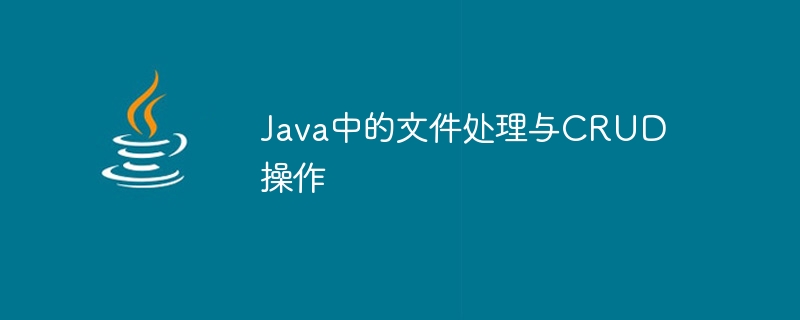Java中的文件处理与CRUD操作

记录处理是编程的一个基本方面,它允许我们与存储在计算机上的文件进行连接。在Java中,通过Record类和其他操作,即CRUD(创建、读取、更新、删除)操作,使文件处理变得方便。在本文中,我们将探讨在Java中执行文件处理的不同方法,每种方法都有自己的优势和使用案例。
语法
在深入研究文件操作的不同方法之前,让我们先熟悉一下在Java中创建记录的基本语言结构。
File file = new File("path/to/file.txt");语法解释
要开始处理Java记录,我们应该使用moment表达式来记录基本类。Record类允许我们通过将文件路径作为参数来创建表示记录的实例。一旦我们有了记录对象,我们就可以执行各种操作,如读取、写入、更新和删除文件。
方法一:使用FileReader和FileWriter
算法
创建一个FileReader对象来从现有文件中读取。
创建一个FileWriter对象来写入文件。
使用循环从输入文件中读取并写入输出文件,直到达到文件末尾。
关闭FileReader和FileWriter对象以释放系统资源。
示例
import java.io.FileReader;
import java.io.FileWriter;
import java.io.IOException;
public class FileHandler {
public static void main(String[] args) {
try {
FileReader reader = new FileReader("input.txt");
FileWriter writer = new FileWriter("output.txt");
int character;
while ((character = reader.read()) != -1) {
writer.write(character);
}
reader.close();
writer.close();
} catch (IOException e) {
e.printStackTrace();
}
}
}输出
Hello, world! This is a sample text file used for testing the file handling code. It contains some random sentences and paragraphs. Feel free to modify and experiment with it as needed. Have a great day!
解释
在这种方法中,我们使用FileReader类从现有记录中读取,并使用FileWriter类输入到记录中。我们创建FileReader和FileWriter对象,指定输入和输出记录的名称,然后使用while循环从输入记录中读取字符并将其输入到输出记录中。最后,我们关闭FileReader和FileWriter对象以释放系统资源。
使用BufferedReader和BufferedWriter的方法
算法
创建一个BufferedReader对象来从现有文件中读取。
创建一个BufferedWriter对象来写入文件。
使用循环从输入文件中读取并写入输出文件,直到达到文件末尾。
关闭 BufferedReader 和 BufferedWriter 对象以释放系统资源。
示例
import java.io.BufferedReader;
import java.io.BufferedWriter;
import java.io.FileReader;
import java.io.FileWriter;
import java.io.IOException;
public class FileHandler {
public static void main(String[] args) {
try {
BufferedReader reader = new BufferedReader(new FileReader("input.txt"));
BufferedWriter writer = new BufferedWriter(new FileWriter("output.txt"));
String line;
while ((line = reader.readLine()) != null) {
writer.write(line);
writer.newLine();
}
reader.close();
writer.close();
} catch (IOException e) {
e.printStackTrace();
}
}
}输出
Hello, world! This is a sample text file used for testing the file handling code. It contains some random sentences and paragraphs. Feel free to modify and experiment with it as needed. Have a great day!
解释
在这种方法中,我们利用BufferedReader类从现有记录中读取数据,并利用BufferedWriter类将数据写入记录中。我们创建BufferedReader和BufferedWriter对象,指定输入和输出记录的名称,然后使用循环从输入记录中读取行并将其写入输出记录中。通过使用readLine()方法,能够更有效地处理文本输入。最后,我们关闭BufferedReader和BufferedWriter对象以释放系统资源。
方法三:使用FileInputStream和FileOutputStream
算法
创建一个FileInputStream对象来从现有文件中读取。
创建一个FileOutputStream对象来写入文件。
使用循环从输入文件中读取并写入输出文件,直到达到文件末尾。
关闭FileInputStream和FileOutputStream对象以释放系统资源。
示例
import java.io.FileInputStream;
import java.io.FileOutputStream;
import java.io.IOException;
public class FileHandler {
public static void main(String[] args) {
try {
FileInputStream inputStream = new FileInputStream("input.txt");
FileOutputStream outputStream = new FileOutputStream("output.txt");
int bytesRead;
byte[] buffer = new byte[1024];
while ((bytesRead = inputStream.read(buffer)) != -1) {
outputStream.write(buffer, 0, bytesRead);
}
inputStream.close();
outputStream.close();
} catch (IOException e) {
e.printStackTrace();
}
}
}输出
Hello, world! This is a sample text file used for testing the file handling code. It contains some random sentences and paragraphs. Feel free to modify and experiment with it as needed. Have a great day!
解释
在这里,我们使用FileInputStream从现有记录中学习,并使用FileOutputStream输入到记录中。我们创建FileInputStream和FileOutputStream对象,指定输入和输出记录的名称,然后使用循环从输入记录中读取字节并将其输入到输出记录中。缓冲区有助于高效地读取和写入数据。最后,我们关闭FileInputStream和FileOutputStream对象以释放系统资源。
方法四:使用Files.copy()和Files.delete()
算法
使用Files.copy()方法将一个文件的内容复制到另一个文件。
使用Files.delete()方法来删除文件。
示例
import java.io.IOException;
import java.nio.file.Files;
import java.nio.file.Path;
import java.nio.file.Paths;
public class FileHandler {
public static void main(String[] args) {
try {
Path source = Paths.get("input.txt");
Path destination = Paths.get("output.txt");
Files.copy(source, destination);
Files.delete(source);
} catch (IOException e) {
e.printStackTrace();
}
}
}输出
Hello, world! This is a sample text file used for testing the file handling code. It contains some random sentences and paragraphs. Feel free to modify and experiment with it as needed. Have a great day!
解释
在这种方法中,我们利用java.nio.file包中的Records类来复制和删除文件。我们使用Paths类指定源文件和目标文件的路径,然后使用copy()方法将源文件的内容复制到目标文件中。在复制操作完成后,我们使用delete()方法删除源文件。这种方法提供了一种快速高效的方式来执行文件复制和删除操作。
结论
记录处理是Java编程的基本部分,了解执行CRUD操作的不同方法可以大大提高您处理记录的能力。在本文中,我们探讨了Java中四种记录处理的方法,每种方法都有其自身的优势和使用案例。通过使用诸如FileReader、FileWriter、BufferedReader、BufferedWriter、FileInputStream、FileOutputStream和Records等类,我们可以轻松地在Java程序中创建、读取、更新和删除记录。通过使用这些方法进行测试,您可以创建强大的记录处理功能,以满足您特定的应用需求。
以上是Java中的文件处理与CRUD操作的详细内容。更多信息请关注PHP中文网其他相关文章!

热AI工具

Undresser.AI Undress
人工智能驱动的应用程序,用于创建逼真的裸体照片

AI Clothes Remover
用于从照片中去除衣服的在线人工智能工具。

Undress AI Tool
免费脱衣服图片

Clothoff.io
AI脱衣机

Video Face Swap
使用我们完全免费的人工智能换脸工具轻松在任何视频中换脸!

热门文章

热工具

记事本++7.3.1
好用且免费的代码编辑器

SublimeText3汉化版
中文版,非常好用

禅工作室 13.0.1
功能强大的PHP集成开发环境

Dreamweaver CS6
视觉化网页开发工具

SublimeText3 Mac版
神级代码编辑软件(SublimeText3)
 突破或从Java 8流返回?
Feb 07, 2025 pm 12:09 PM
突破或从Java 8流返回?
Feb 07, 2025 pm 12:09 PM
Java 8引入了Stream API,提供了一种强大且表达力丰富的处理数据集合的方式。然而,使用Stream时,一个常见问题是:如何从forEach操作中中断或返回? 传统循环允许提前中断或返回,但Stream的forEach方法并不直接支持这种方式。本文将解释原因,并探讨在Stream处理系统中实现提前终止的替代方法。 延伸阅读: Java Stream API改进 理解Stream forEach forEach方法是一个终端操作,它对Stream中的每个元素执行一个操作。它的设计意图是处
 PHP:网络开发的关键语言
Apr 13, 2025 am 12:08 AM
PHP:网络开发的关键语言
Apr 13, 2025 am 12:08 AM
PHP是一种广泛应用于服务器端的脚本语言,特别适合web开发。1.PHP可以嵌入HTML,处理HTTP请求和响应,支持多种数据库。2.PHP用于生成动态网页内容,处理表单数据,访问数据库等,具有强大的社区支持和开源资源。3.PHP是解释型语言,执行过程包括词法分析、语法分析、编译和执行。4.PHP可以与MySQL结合用于用户注册系统等高级应用。5.调试PHP时,可使用error_reporting()和var_dump()等函数。6.优化PHP代码可通过缓存机制、优化数据库查询和使用内置函数。7
 PHP与Python:了解差异
Apr 11, 2025 am 12:15 AM
PHP与Python:了解差异
Apr 11, 2025 am 12:15 AM
PHP和Python各有优势,选择应基于项目需求。1.PHP适合web开发,语法简单,执行效率高。2.Python适用于数据科学和机器学习,语法简洁,库丰富。
 PHP与其他语言:比较
Apr 13, 2025 am 12:19 AM
PHP与其他语言:比较
Apr 13, 2025 am 12:19 AM
PHP适合web开发,特别是在快速开发和处理动态内容方面表现出色,但不擅长数据科学和企业级应用。与Python相比,PHP在web开发中更具优势,但在数据科学领域不如Python;与Java相比,PHP在企业级应用中表现较差,但在web开发中更灵活;与JavaScript相比,PHP在后端开发中更简洁,但在前端开发中不如JavaScript。
 Java程序查找胶囊的体积
Feb 07, 2025 am 11:37 AM
Java程序查找胶囊的体积
Feb 07, 2025 am 11:37 AM
胶囊是一种三维几何图形,由一个圆柱体和两端各一个半球体组成。胶囊的体积可以通过将圆柱体的体积和两端半球体的体积相加来计算。本教程将讨论如何使用不同的方法在Java中计算给定胶囊的体积。 胶囊体积公式 胶囊体积的公式如下: 胶囊体积 = 圆柱体体积 两个半球体体积 其中, r: 半球体的半径。 h: 圆柱体的高度(不包括半球体)。 例子 1 输入 半径 = 5 单位 高度 = 10 单位 输出 体积 = 1570.8 立方单位 解释 使用公式计算体积: 体积 = π × r2 × h (4
 PHP与Python:核心功能
Apr 13, 2025 am 12:16 AM
PHP与Python:核心功能
Apr 13, 2025 am 12:16 AM
PHP和Python各有优势,适合不同场景。1.PHP适用于web开发,提供内置web服务器和丰富函数库。2.Python适合数据科学和机器学习,语法简洁且有强大标准库。选择时应根据项目需求决定。
 创造未来:面向零基础的 Java 编程
Oct 13, 2024 pm 01:32 PM
创造未来:面向零基础的 Java 编程
Oct 13, 2024 pm 01:32 PM
Java是热门编程语言,适合初学者和经验丰富的开发者学习。本教程从基础概念出发,逐步深入讲解高级主题。安装Java开发工具包后,可通过创建简单的“Hello,World!”程序实践编程。理解代码后,使用命令提示符编译并运行程序,控制台上将输出“Hello,World!”。学习Java开启了编程之旅,随着掌握程度加深,可创建更复杂的应用程序。
 PHP:许多网站的基础
Apr 13, 2025 am 12:07 AM
PHP:许多网站的基础
Apr 13, 2025 am 12:07 AM
PHP成为许多网站首选技术栈的原因包括其易用性、强大社区支持和广泛应用。1)易于学习和使用,适合初学者。2)拥有庞大的开发者社区,资源丰富。3)广泛应用于WordPress、Drupal等平台。4)与Web服务器紧密集成,简化开发部署。






